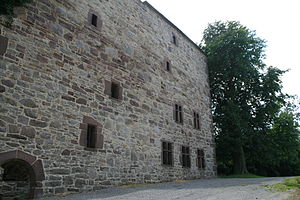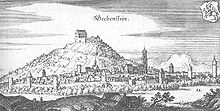Grebenstein Castle
| Grebenstein Castle | ||
|---|---|---|
|
Palas of Grebenstein Castle, 2008 |
||
| Alternative name (s): | Grafenstein, Greuensteyn, Grevenstein | |
| Creation time : | around 1272 | |
| Castle type : | Hilltop castle | |
| Conservation status: | Wall remains, hall | |
| Standing position : | Nobles | |
| Place: | Grebenstein | |
| Geographical location | 51 ° 26 '30 " N , 9 ° 24' 55" E | |
| Height: | 249 m above sea level NN | |
|
|
||
The Burg Grebenstein , also Grafstein , Greuensteyn , Grevenstein called, is the ruins of a hilltop castle above the core city of Grebenstein in Kassel district in Hesse .
Geographical location
The castle ruin stands at 249 m above sea level. NN high Castle Hill, one of the Diemel influx Esse semi reflowed basalt cone on the southern edge of Grebenstein - about 56 meters above the city.
history
A historically rather insignificant original castle complex was built in the second half of the 11th century. From 1266 or soon after, Count Ludolf V von Dassel expanded the castle to protect his surrounding property. This castle is first mentioned in a document in 1272 - in connection with disputes between the diocese of Paderborn and the Landgrave Heinrich I of Hesse , whereby it concerns the border regulations of the castles Schartenberg and Grebenstein as well as the court on the hornbeam.

By marriage, the castle and town of Grebenstein, which were Mainz fiefs , passed to Ludolf's son-in-law, Otto von Everstein , around 1279 . In the same year the Paderborn Bishop-Elect promised Otto von Rietberg the Archbishop of Mainz, Werner , in a deal the former Dassel 'rule Mainzer aristocratic estates Scharteberg and Grebenstein relating to scuffing your castle Grebenstein. This did not happen, however, because Landgrave Heinrich von Hessen apparently owned the castle at least partially from 1282. Otto von Everstein himself entered the service of the landgrave as a castle man in 1293 and opened all of his castles to him, including those to be acquired in the future. Then the Hessian castle men Tammo von Alnhausen, Willekin Hase and Johann Riedesel were trustees at the castle. On August 28, 1297 Otto von Everstein sold the castle and town of Grebenstein with the court and all accessories to Landgrave Heinrich I and was replaced as Burgmann. Until 1529 the castle was occupied by Hessian officials .
As a Hessian post opposite the main hiss Hofgeismar filled Grebenstein initially an important function in Diemel country, although after 1282 heavily fortified city with its anti Hofgeismar Landwehr was more important than the less suitable for military purposes Castle.
In 1328, when Heinrich II took office as Landgrave of Hesse, his brother Ludwig the Junker (1305–1345) received Grebenstein Castle and the property belonging to it as a paragium . In 1341 his son Hermann II , later Landgrave of Hesse, was born in the castle. From 1349 to 1368 the castle was then owned by Hermann I, "the Elder" († 1368/1370), another brother of Landgrave Heinrich II.
In 1385 the castle was besieged in vain in the course of a renewed feud with the landgraves by troops of Archbishop Adolf I of Mainz .
After the entire Mainz property between Weser and Diemel was pledged to Landgrave Ludwig due to war debts from the Mainz collegiate feud (1461–1463) and subsequently finally passed into Hessian ownership, the castle lost its strategic importance. As early as 1471, there was probably only one clerk left at the castle. It was probably no longer inhabited since around 1540 and instead served as a harvest store.
In the Thirty Years War , Grebenstein castle and town were destroyed in 1631. After that, the townspeople used the castle ruins as a quarry to rebuild the town and left the rest to decay. Only at the end of the 20th century were the ruins structurally secured.
investment
The Grebenstein castle ruins are dominated by the 37-meter-long and 12-meter-wide palas , the outer walls of which have been almost completely preserved and still reach a height of over 13 meters. The hall had a basement and three upper floors. Remnants of bay windows and chimneys , the kitchen in the basement and the former bower (women's chamber) have also remained. On the first floor, the wall is almost 3 meters thick. The plant is of a still partially preserved moat surrounding, but the dimensions of the forecastle , and the trenches are only guessed at. The restored facilities are now freely accessible and can be viewed at any time.
After the ascent to the "Burgberg" via one of the educational trails , a steel staircase can be used to climb a viewing platform on the upper brickwork of the castle ruins. From here there is an overview of the historic old town of Grebenstein as well as the Habichtswald and Reinhardswald .
There is a small Jewish cemetery below the castle .
Bailiffs
Officially attested officials were u. a .:
- 1336 Ludwig von Grebenstein
- 1339 Johann von Schachten
- around 1350 Hermann von Uffeln
- 1355 Willekin Rabbit the Elder
- 1375 Friedrich II. Von Hertingshausen, Ditmar von Hanstein
- 1383 Dietrich von Schachten (?)
- 1385–1399 Mainz interim administration - Konrad von Spiegel zum Desenberg
- 1414 Frederick III. from Hertingshausen
- 1417 Johann von Wolmeringhausen , known as the Kühne
- 1421, 1426, 1436 Eckebrecht von Schachten
- 1426 Heinrich Hase
- 1428 Werner von Uffeln
- 1455-before 1466 Eckebrecht von Schachten
- 1472–1482 Werner von Elben
- 1485–1487, 1496–1498 Dietrich von Schachten
- 1493–1494 Friedrich Trott the Younger
- 1498 Eberhard Hake
- 1499–1514 Dietrich von Schachten the Younger
- 1528, 1530 Jorg von Schachten
- 1529 Heiderich von Kalenberg
literature
- Helmut Burmeister: Princes, facts, half-timbered buildings. An encyclopedia on the history of the city of Grebenstein . Hofgeismar 1988.
- Karl Ernst Demandt : The personal state of the Landgraviate of Hesse in the Middle Ages . Marburg 1981.
- Kurt Günther: Territorial history of the landscape between Diemel and Oberweser from the 12th to the 16th century . Diss. Marburg 1959, first printing: Immenhausen 1986.
- Homeland yearbook of the Hofgeismar district 1957 . Pp. 46-47.
- Rudolf Knappe: Medieval castles in Hessen. 800 castles, castle ruins and fortifications. 3. Edition. Wartberg-Verlag, Gudensberg-Gleichen 2000, ISBN 3-86134-228-6 , p. 14.
- Wolfgang Tölle: Castle and City of Grebenstein . Grebenstein: Support group of the Ackerbürgermuseum , 1988
Web links
- Grebenstein Castle on the burgen.de site
- Grebenstein Castle on the burgenwelt.de site
- "Grebenstein Castle, Kassel District". Historical local dictionary for Hessen. In: Landesgeschichtliches Informationssystem Hessen (LAGIS).



